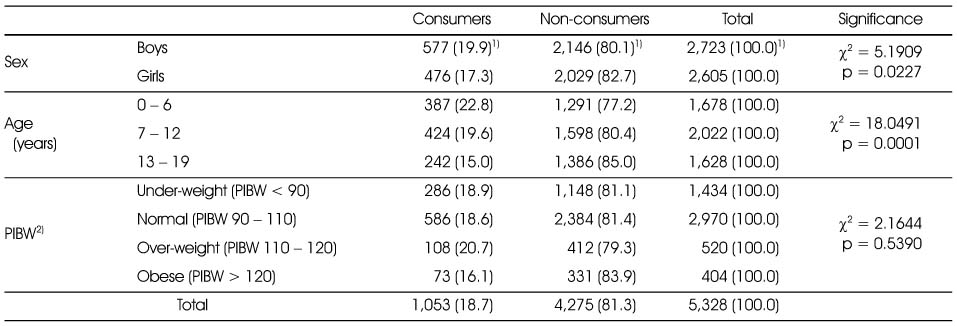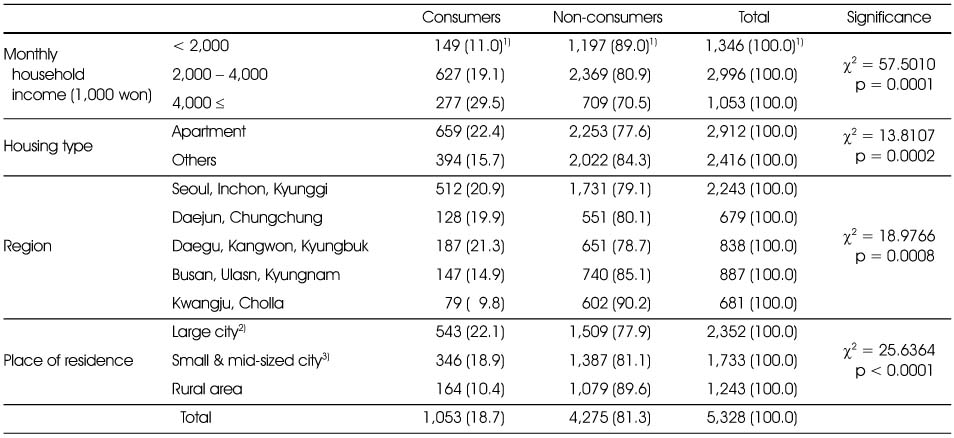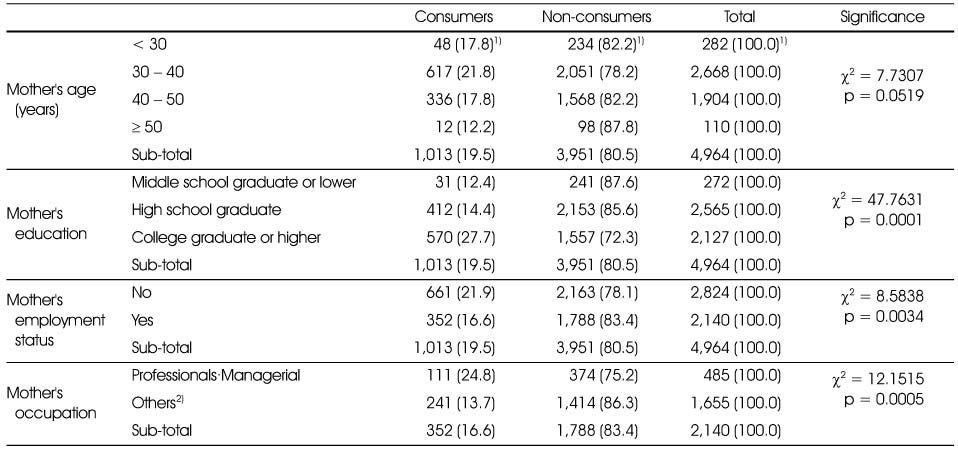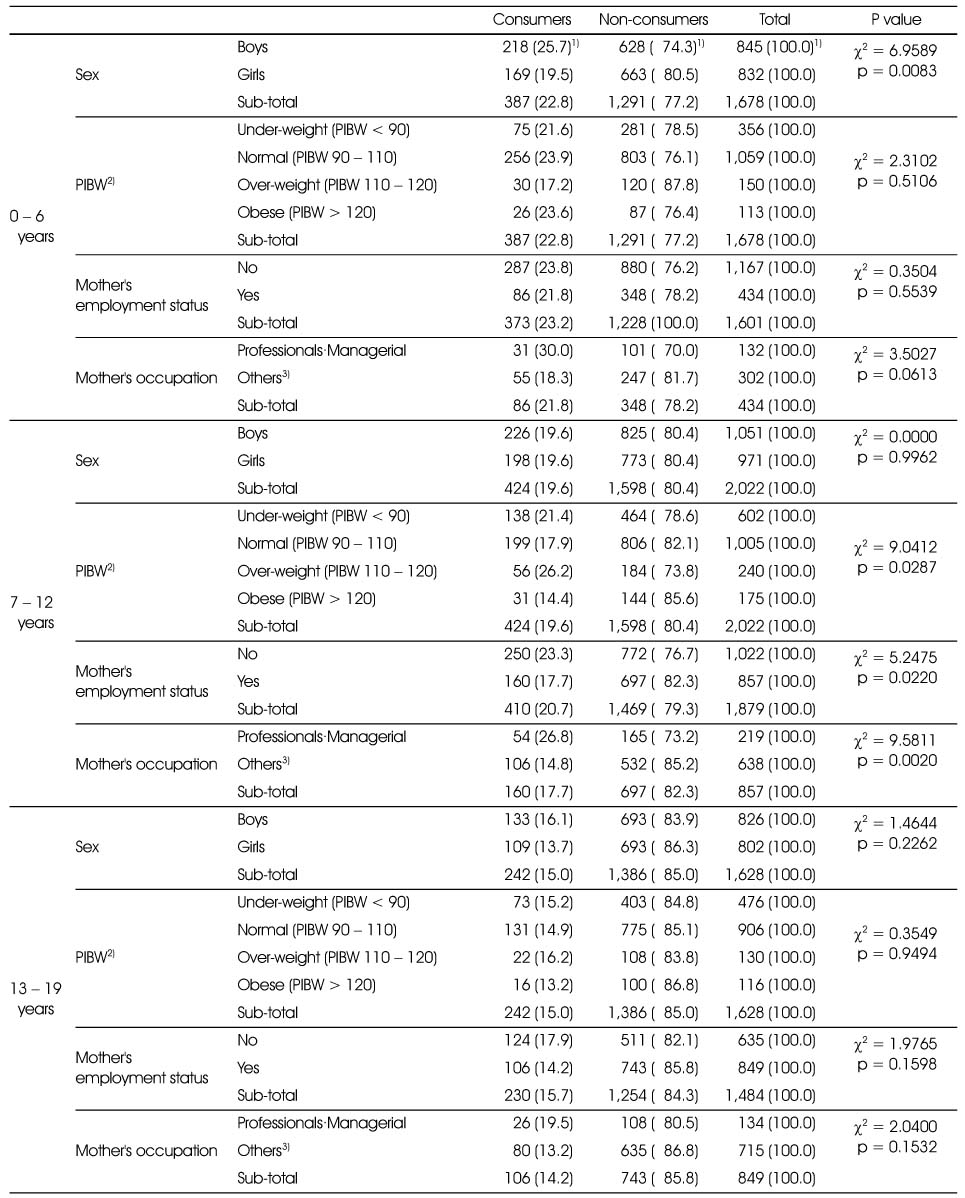Articles
- Page Path
- HOME > Korean J Community Nutr > Volume 16(6); 2011 > Article
-
Original Article
- Influencing Factors on the Dietary supplements Consumption among Children in Korea
- Jeeyeon Lee, Dohee Kim, Yoonna Lee, Eunmi Koh, Youngsoo Jang, Hyeyoung Lee, Youngae Jang, Cho-il Kim
-
Korean Journal of Community Nutrition 2011;16(6):740-750.
DOI: https://doi.org/10.5720/kjcn.2011.16.6.740
Published online: December 31, 2011
Nutrition Policy & Promotion Team, Korea Health Industry Development Institute, Chungbuk, Korea.
1Health · Functional Food Standardization Division, Korea Food & Drug Administration, Chungbuk, Korea.
2NongShim Ltd. Seoul, Korea.
- Corresponding author: Cho-il Kim, Department of Food & Nutrition Industry, Korea Health Industry Development Institute, Osong Health Technology Administration Complex, 187 Osongsaengmyeong2-ro, Gangoe-myeon, Cheongwon-gun, Chungbuk 363-700, Korea. Tel: (043)713-8611, Fax: (043) 713-8907, kimci@khidi.or.kr
Copyright © 2011 The Korean Society of Community Nutrition
- 427 Views
- 0 Download
- 5 Crossref
Abstract
- With a recent increase in dietary supplements (DS) consumption among children in Korea, this study was performed to examine the influencing factors on children's DS consumption. A nationwide survey was conducted employing 3 representative samples of children for summer & fall of 2008 and spring of 2009 by stratified multistage sampling of 120 survey sites per season based on the 2005 census population. Approximately 30 households from each survey site were screened for residing children of 0-19 years and about 1,700 households remained as eligible samples per season. Trained dietitians visited households to perform face-to-face interview to children and/or parents regarding DS consumption including health functional foods (HFF), vitamins/minerals (V/M) supplements and other food supplements during 1 month prior to interview. Out of 5,328 children responded, 18.7% reported DS consumption. Consumption rate was higher in boys (19.9% vs. 17.3% in girls, P < 0.05) and youngsters (22.8% compared to 15.0% in adolescents, P < 0.001). Children from higher income family (P < 0.001), those living in apartments (P < 0.001), those residing in metropolitan area (P < 0.001), and those of mothers with higher education (P < 0.001) were more likely to take DS. Also, mother's employment status and occupation were significantly associated with children's DS consumption. The most popular DS was HFF (72.1%), which was consumed more in children of higher income family. It is revealed that socioeconomic factors affect children's DS consumption significantly. Also it is necessary to estimate children's V/M intake from DS and foods together especially because there are tolerable upper limits set for V/M for safety purposes.
- 1. Cha YS, Kim JS, Rho JO. A study on the patterns of nutrient supplement usage and its related influencing factors of high school students in Chonbuk area. J Korean Living Sci Assoc. 2007; 16(6): 1231-1241.Article
- 2. Chung HK, Lee HY. Consumption of health functional foods according to age group in some regions of Korea. J Korean Diet Assoc. 2011; 17(2): 190-205.
- 3. Codex Alimentarius Commission. Report of the 25th session of the codex committee on nutrition and foods for special dietary uses. 2003; 3-7.
- 4. Hathcock JN, Shao A. Expanded approach to tolerable upper intake guidelines for nutrients and bioactive substances. J Nutr. 2008; 138(10): 1992S-1995S.ArticlePubMed
- 5. MOHW. KHIDI. The third Korea National Health & Nutrition Examination Survey, 2005-Nutrition Survey I. 2006; 777.
- 6. MOHW. KCDC. Korea health statistics 2009. 2010; 32-33.
- 7. KCDC. Korean Pediatric Society. Standard growth chart for children and adolescents. 2007.
- 8. Law for health functional foods. KFDA. 2004; cited 2011 October 25. Available from www.kfda.go.kr.
- 9. Kim EM, Jung HJ, Jung JY, Kim JW. Analysis of elementary students' intake of dietary supplements. Korean J Food Cookery Sci. 2008; 24(5): 671-681.
- 10. Kim HJ, Kim MR. A study on health-functional foods intake pattern of consumers in Busan and Gyeongnam region. J Korean Living Sci Assoc. 2006; 15(2): 341-352.
- 11. Kim SH. A survey on the use of and significant variables for health functional foods among Korean elderly. Korean J Food Cult. 2011; 26(1): 30-38.
- 12. Kim SH, Han JH, Hwang YJ, Kim WY. Use functional foods for health by 14~18 year old students attending general junior or senior high schools in Korea. Korean J Nutr. 2005; 38(10): 864-872.
- 13. Kim SH, Han JH, Kim WY. Consumption of health functional foods by elementary school children in Korea. Korean J Food Cult. 2010; 25(2): 117-125.Article
- 14. Kim SH, Leen CL. Vitamin and mineral supplement use among children attending elementary schools in Korea: a survey of eating habits and dietary consequences. Nutr Res. 2002; 22(4): 433-448.Article
- 15. Kim SN, Kim SH. A survey on use of vitamin mineral supplements by children in Daejeon city and Chungcheong porvince in Korea. Korean J Food Cult. 2010; 25(2): 117-125.
- 16. Korea Health Supplement Association. Report on health functional foods in Korea. sales trends and prospects. 2009.
- 17. Lee YO, Song Y. Sociodemographic characteristics, lifestyle factors, and nutrient intake by taking vitamin mineral supplements. Korean J Food Cult. 2010; 25(4): 480-486.
- 18. Park JS, Lee JH. Elementary school children's intake pattern's of health functional foods and parents requirements in Daejeon area. Korean J Community Nutr. 2008; 13(4): 463-475.
- 19. Song BC, Kim MK. Patterns of vitamin-mineral supplement use among preschool children in Korea. Korean J Nutr. 1998; 30(2): 357-363.
- 20. Yoo YJ, Hong WS, Choi YS. The experience of nutrient supplement use among adults in the Seoul area. J Korean Soc Food Sci Nutr. 2001; 30(2): 357-363.
- 21. Yoo YJ, Hong WS, Youn SJ, Choi YS. The experience of health food usage for adults in Seoul. Korean J Food Cookery Sci. 2002; 18(2): 136-146.
- 22. Zlotkin S. A critical assessment of upper intake levels for infants and children. J Nutr. 2006; 136(2): 502S-506S.PubMed
REFERENCES
Figure & Data
REFERENCES
Citations

- A Study on the Dietary Behavior of Korean Adults: Focus on Dietary Supplement Intake, Household Size, and COVID-19
Jinkyung Choi
Korean Journal of Community Nutrition.2022; 27(6): 468. CrossRef - Use of vitamin and mineral supplements and related variables among university students in Seoul
Jung-Hwa Choi, Youjin Je
Journal of Nutrition and Health.2015; 48(4): 352. CrossRef - The Status of Dietary Supplements Intake in Korean Preschool Children: Data from the Korea National Health and Nutrition Examination Survey 2010-2012
Dong Soo Kang, Kun Song Lee
Pediatric Gastroenterology, Hepatology & Nutrition.2014; 17(3): 178. CrossRef - A Survey on the Usage Patterns of Vitamin and Mineral Supplements as Over-The-Counter Drugs among Korean Adolescents
Ji Hye Han, Hyun Sook Lee, Sun Hyo Kim
Journal of the Korean Society of Food Culture.2014; 29(4): 364. CrossRef - Dietary Supplements Use and Related Factors of Preschoolers in 3 Korean Cities
Hye Sil Kim, Hye Young Lee, Mi Kyung Kim
Pediatric Gastroenterology, Hepatology & Nutrition.2013; 16(2): 104. CrossRef
General characteristics of the respondents by age
1) Frequency (percent by weighted frequency)
2) Percent Ideal Body Weight
Proportion (%) of children who consumed dietary supplements (DS): general characteristics
1) Frequency (percent by weighted frequency)
2) Percent Ideal Body Weight
Proportion (%) of children who consumed DS: socio-economic characteristics
1) Frequency (percent by weighted frequency)
2) Large city: Seoul, Inchon, Daejun, Daegu, Busan, Usan
3) Small & mid-sized city: Other cities
Proportion (%) of children who consumed DS: mother's characteristics
1) Frequency (percent by weighted frequency)
2) clerk, skilled labor or service, etc.
Proportion (%) of children who consumed each type of DS (DS consumers only)
1) Multiple choice
2) Frequency (percent by weighted frequency by DS consumers)
Proportion (%) of children who consumed functional foods (DS consumers only)
1) Frequency (percent by weighted frequency)
2) Total no. of DS consumers
Proportion (%) of children who consumed vitamins/minerals (DS consumers only)
1) Frequency (percent by weighted frequency)
2) Total no. of DS consumers
Proportion (%) of children who consumed other supplements (DS consumers only)
1) Frequency (percent by weighted frequency)
2) Total no. of DS consumers
Proportion(%) of children who consumed DS by other characteristics at each age group
1) Frequency (percent by weighted frequency
2) Percent Ideal Body Weight
3) clerk, skilled labor or service, etc.
Distribution of respondents by housing type and monthly household income
Distribution of respondents region and monthly household income
1) Frequency (percent by weighted frequency) 2) Percent Ideal Body Weight
1) Frequency (percent by weighted frequency) 2) Percent Ideal Body Weight
1) Frequency (percent by weighted frequency) 2) Large city: Seoul, Inchon, Daejun, Daegu, Busan, Usan 3) Small & mid-sized city: Other cities
1) Frequency (percent by weighted frequency) 2) clerk, skilled labor or service, etc.
1) Multiple choice 2) Frequency (percent by weighted frequency by DS consumers)
1) Frequency (percent by weighted frequency) 2) Total no. of DS consumers
1) Frequency (percent by weighted frequency) 2) Total no. of DS consumers
1) Frequency (percent by weighted frequency) 2) Total no. of DS consumers
1) Frequency (percent by weighted frequency 2) Percent Ideal Body Weight 3) clerk, skilled labor or service, etc.

 KSCN
KSCN











 PubReader
PubReader Cite
Cite


